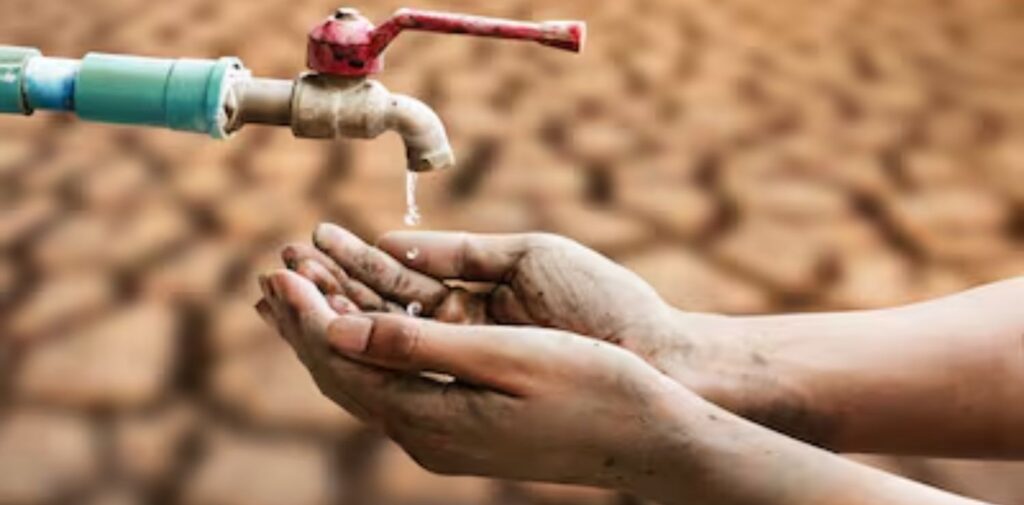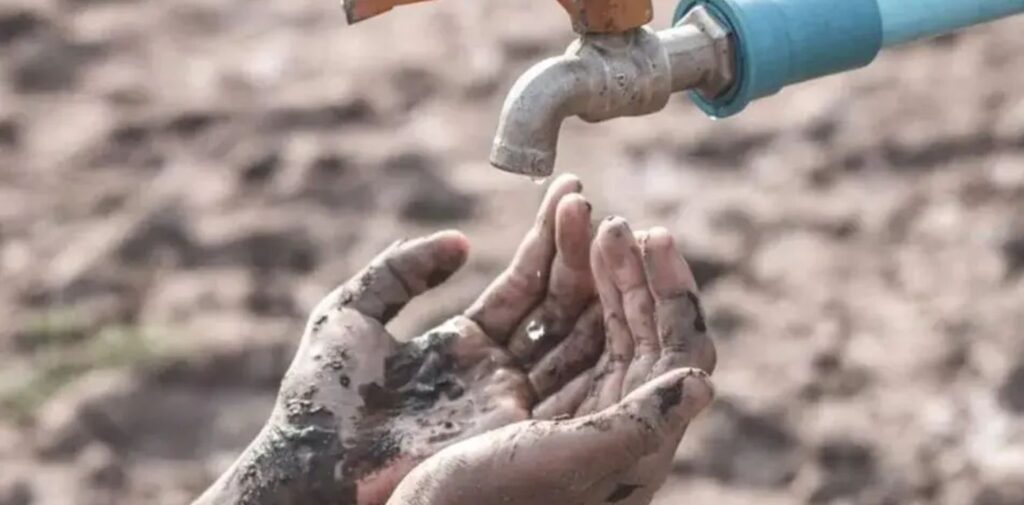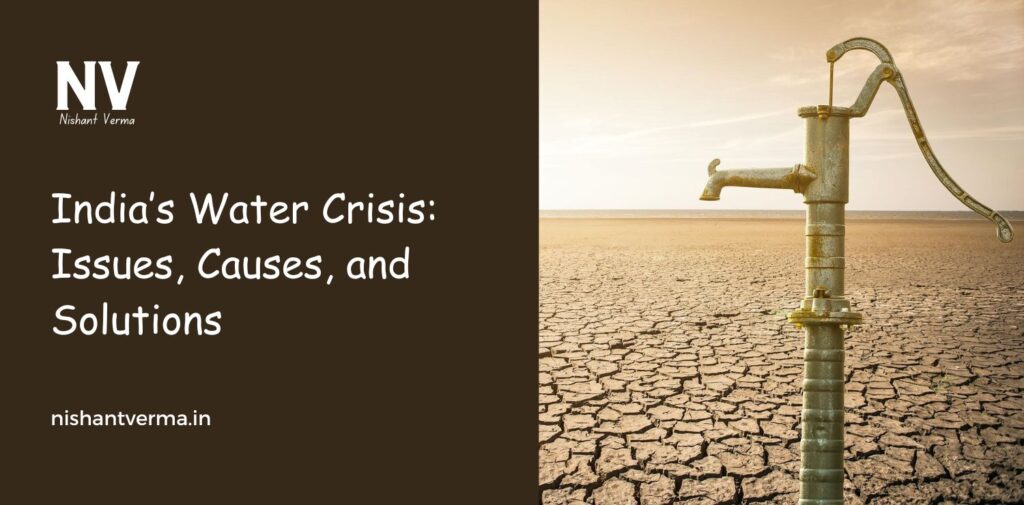Water is one of the most important resources on Earth. It is essential for life, for growing food, for industry, and everyday use like drinking and bathing. However, India is facing a serious water crisis, which means there is not enough clean water for everyone. This is a problem that affects millions of people in India and could lead to even more difficulties if not addressed. In this article, we will look at the issues, causes, and possible solutions to India’s water crisis.
What is the Water Crisis?
A water crisis happens when there is not enough water to meet the needs of the people. It means that people cannot get enough clean water to drink, cook, bathe, or use in farming and industry. India is experiencing a water crisis because the water demand is much higher than the supply. This problem affects not only rural areas but also many cities where millions of people live.

The Importance of Water
Water is essential for many things in life. It is needed to:
- Drink: Our bodies need water to stay healthy.
- Grow Food: Crops and plants need water to grow. Without water, we cannot have food.
- Industry: Water is used in factories and for making products.
- Daily Life: We use water every day for cleaning, cooking, and personal hygiene.
Without enough water, people can face serious problems like hunger, disease, and poor health.
The Issues of India’s Water Crisis
India’s water crisis is a big problem, and it has many different issues connected to it. These issues affect the environment, the economy, and the people’s quality of life.
- Water Shortage in Rural Areas: Many villages and small towns in India do not have easy access to clean drinking water. In some areas, people have to walk long distances to get water from wells, rivers, or ponds. Even when they do find water, it is often not clean, and it may cause diseases. This leads to poor health, especially for children.
- Pollution of Water Sources: Many rivers, lakes, and ponds in India are polluted. This pollution comes from factories, agricultural runoff (chemicals used in farming), sewage (waste from homes), and plastic waste. When water is polluted, it becomes unsafe for people to drink, wash, or use for farming. Polluted water can lead to dangerous diseases like cholera, dysentery, and diarrhoea.
- Water Wastage: In many parts of India, water is being wasted. People use water carelessly for things like washing cars, watering gardens, and leaving taps running. In farming, large amounts of water are used to irrigate crops, but often this water is not used efficiently. Wasting water is a big problem because it makes the water crisis worse.
- Unequal Distribution of Water: Not all areas in India have the same amount of water. Some states have plenty of water, while others do not. The states with less water face bigger problems. The population in these areas grows, and the demand for water increases, but there is not enough to go around. This causes tensions between states and local communities, making the water crisis even harder to solve.
- Climate Change: Climate change is making the water crisis worse. India is experiencing more unpredictable weather, including droughts and floods. In some places, there is too little rain, while in other places, there are heavy rains that cause floods. Both of these problems make it harder to manage water resources. Droughts can dry up rivers and lakes, while floods can cause water to become polluted.

The Causes of India’s Water Crisis
Several factors contribute to India’s water crisis. These causes are both natural and human-made. Let’s look at some of the major reasons why India is facing a water crisis.
- Population Growth: India has a very large population, with over 1.4 billion people. As the population grows, the demand for water increases. More people need water for drinking, cooking, washing, and farming. This puts pressure on water resources, making it difficult to provide enough clean water for everyone.
- Over-extraction of Groundwater: Many farmers and industries in India use groundwater for irrigation and other needs. Groundwater is water found beneath the earth’s surface, and it is usually accessed by wells or boreholes. However, in many areas, groundwater is being used faster than it can be replenished. This means that the water table is going down, and soon there may not be enough groundwater left to use.
- Poor Water Management: Water resources in India are not always managed well. Sometimes, water is not stored properly during the rainy season. There are also leaks in pipes and reservoirs, which cause water to be wasted. In many cases, water is not shared equally between different groups of people, leading to conflicts.
- Pollution: As mentioned earlier, pollution is a major cause of India’s water crisis. Factories, industries, and households dump waste into rivers and lakes, which pollutes the water. This pollution makes the water unsafe to drink or use for farming. Some of the most polluted rivers in India, like the Ganga and Yamuna, are considered sacred but are heavily polluted.
- Deforestation: Cutting down trees in forests contributes to water problems. Trees help in the natural process of rainwater absorption, and when they are cut down, less rainwater is able to seep into the ground. This leads to reduced groundwater levels and even more water shortages.

Solutions to India’s Water Crisis
While India’s water crisis is a big problem, there are many solutions that can help. The government, communities, and individuals can all play a role in solving this issue. Let’s look at some of the possible solutions.
- Water Conservation: One of the simplest and most effective ways to solve the water crisis is by using water more wisely. People can save water by turning off taps when not in use, fixing leaks, and using water-efficient appliances. In farming, drip irrigation and rainwater harvesting systems can help save water and use it more efficiently.
- Pollution Control: India needs to improve the quality of its water sources by stopping pollution. The government should enforce stricter rules for industries and factories to treat waste before it is released into rivers and lakes. People can also help by reducing their use of plastic and properly disposing of waste.
- Rainwater Harvesting: Rainwater harvesting is a technique where rainwater is collected and stored for future use. This can be done in homes, schools, and communities. In areas where there is not enough water, collecting rainwater can provide an important source of clean water. This solution is especially useful in regions with seasonal rainfall.
- Improved Water Management: The government should invest in better water management systems. This includes building more efficient reservoirs, repairing old water pipes, and using modern technology to track water usage. Proper management can help reduce water wastage and ensure that everyone gets their fair share of water.
- Reforestation: Planting more trees and protecting forests can help restore the natural water cycle. Trees help in absorbing rainwater and preventing soil erosion. When forests are preserved and expanded, they play an important role in maintaining the water balance and helping groundwater levels.
- Awareness and Education: Educating people about the importance of water conservation and how they can help is also an important solution. Schools, community groups, and media campaigns can teach people how to save water and protect water sources. This will encourage everyone to take responsibility for their water use.
Conclusion
India’s water crisis is a serious problem, but it is not impossible to solve. By using water more wisely, controlling pollution, managing water resources better, and planting more trees, India can make progress in solving the water crisis. It is also important for the government, businesses, and individuals to work together to protect water sources and ensure that everyone has access to clean and safe water.
The future of India’s water resources depends on the actions taken today. If we all do our part, we can make sure that future generations have enough water to live healthy and happy lives.




